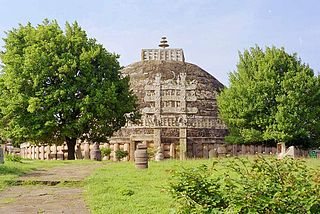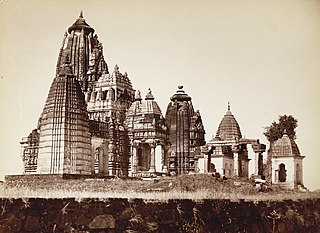Dhar is a city located in Dhar district of the Malwa region in the state of Madhya Pradesh, India. The city is the administrative headquarters of the Dhar district. Before Indian independence from Great Britain, it was the capital of the Dhar princely state.

Vidisha is a city in central Madhya Pradesh, India. It is located 62.5 km northeast of the state capital, Bhopal. The name "Vidisha" is derived from the nearby river "Bais", mentioned in the Puranas.

Bhoja was an Indian king from the Paramara dynasty. His kingdom was centered around the Malwa region in central India, where his capital Dhara-nagara was located. Bhoja fought wars with nearly all his neighbours in attempts to extend his kingdom, with varying degrees of success. At its zenith, his empire extended from Chittor in the north to upper Konkan in the south, and from the Sabarmati River in the west to Vidisha in the east.

Chanderi, is a town of historical importance in Ashoknagar District of the state Madhya Pradesh in India. It is situated at a distance of 127 km from Shivpuri, 37 km from Lalitpur, 55 km from Ashok Nagar and about 46 km from Isagarh. It is surrounded by hills southwest of the Betwa River. Chanderi is surrounded by hills, lakes and forests and is spotted with several monuments of the Bundela Rajputs and Malwa sultans. It is famous for ancient Jain Temples. Its population in 2011 was 33,081.
Ashoknagar is a city and a Municipality Council in Ashoknagar District in Madhya Pradesh state of central India. It is the administrative headquarters of Ashoknagar District. Earlier it was part of Guna district. Ashoknagar is well known for its Grain Mandi and "Sharbati Gaihu", a type of wheat. The nearest city Guna 45 km from the city. Ashoknagar was formerly known as Pachar. The railway line passes from the middle of the city. Ashoknagar has a railway station and Two Bus stations. Ashoknagar is connected to the main cities of Madhya Pradesh by road and railway.
Samarangana Sutradhara, sometimes referred to as Samarāṅgaṇasūtradhāra, is an 11th-century poetic treatise on classical Indian architecture written in Sanskrit language attributed to Paramara King Bhoja of Dhar. The title Samarāṅgaṇasūtradhāra is a compound word that literally means "architect of human dwellings", but can also be decomposed to an alternate meaning as "stage manager for battlefields" – possibly a play of words to recognize its royal author.

Jainism has been present in Maharashtra since ancient times. The famous Ellora Caves demonstrate that Jainism was part of a thriving religious culture in Maharashtra in premodern times.

Mangi-Tungi is a prominent twin-pinnacled peak with plateau in between, located near Tahrabad about 125 km from Nashik, Maharashtra, India. Mangi, 4,343 ft (1,324 m) high above sea level, is the western pinnacle and Tungi, 4,366 ft (1,331 m) high, the eastern. Mangi-Tungi is 30 km (19 mi) from the city of Satana.

Tourism in Madhya Pradesh has been an attraction of India because of its location in the centre of the country. Madhya Pradesh has won Best Tourism State National award for 3 consecutive years i.e. 2017, 2016 and 2015.

The Jain temples of Khajuraho are a part of the UNESCO World Heritage Site of Khajuraho. They are located in Chhatarpur district, Madhya Pradesh, India, about 175 kilometres southeast of the city of Jhansi.

Bhumija is a variety of north Indian temple architecture marked by how the rotating square-circle principle is applied to construct the shikhara on top of the sanctum. Invented about the 10th-century in the Malwa region of central India during the Paramara dynasty rule, it is found in Hindu and Jain temples. Most early and elegant examples are found in and around the Malwa region, but this design is also found in Gujarat, Rajasthan, Deccan and some major Hindu temple complexes of southern and eastern India.

The history of Madhya Pradesh can be divided into three periods - the ancient period, the medieval period and modern period.

The Paramara Dynasty was an Indian dynasty that ruled Malwa and surrounding areas in west-central India between 9th and 14th centuries. They belonged to the Parmara clan of the Rajputs.

The Bhojshala is an historic building located in Dhar, Madhya Pradesh, India. The name is derived from the celebrated king Bhoja of the Paramāra dynasty of central India, a patron of education and the arts, to whom major Sanskrit works on poetics, yoga and architecture are attributed. The term Bhojashala became linked to the building in the early 20th century; the architectural parts of the structure itself are of different periods but mainly date the 12th century, with the Islamic tombs in the campus added between the 14th and 15th century.
Bhima I was a Chaulukya king who ruled parts of present-day Gujarat, India. The early years of his reign saw an invasion from the Ghaznavid ruler Mahmud, who sacked the Somnath temple. Bhima left his capital and took shelter in Kanthkot during this invasion, but after Mahmud's departure, he recovered his power and retained his ancestral territories. He crushed a rebellion by his vassals at Arbuda, and unsuccessfully tried to invade the Naddula Chahamana kingdom. Towards the end of his reign, he formed an alliance with the Kalachuri king Lakshmi-Karna, and played an important role in the downfall of the Paramara king Bhoja.
Jayasiṃha, who assumed the title Siddharāja, was an Indian king who ruled western parts of India. He was a member of the Chaulukya dynasty.
Udaypur is a town in the Indian state of Madhya Pradesh near Ganj Basoda. It is the site of a well-preserved Śiva temple, a monument of national importance protected by the Archaeological Survey of India.

The Bhojeshwar Temple is an incomplete Hindu temple in Bhojpur village of Madhya Pradesh, India. Dedicated to Shiva, it houses a 7.5-foot (2.3 m) high lingam in its sanctum.
Sindhuraja was an Indian king from the Paramara dynasty, who ruled the Malwa region in the late 10th century. He was the younger brother of Munja, and the father of Bhoja.

The Nīlakaṇṭheśvara temple, Udaypur is a large medieval temple dedicated to Śiva in the town on of Udaypur, Madhya Pradesh. The temple is a Protected Monument of National Importance under the Archaeological Survey of India, number N-MP-289 in the List of Monuments of National Importance in Madhya Pradesh/East. The temple, also known as the Udayeśvara, was built by king Udayaditya in the second half of the eleventh century. It is the only surviving royal temple of the Paramara kings.

























